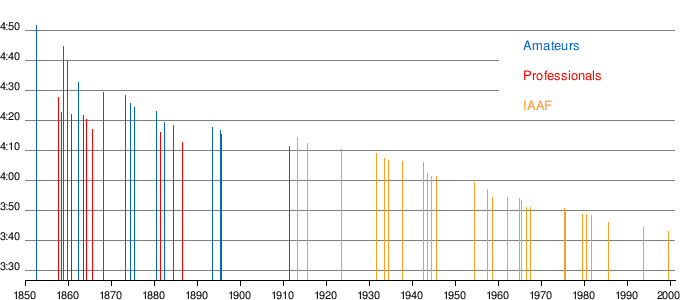The 4-Minute Mile Effect
post by Parker Conley (parker-conley) · 2025-04-14T21:41:27.726Z · LW · GW · 4 commentsThis is a link post for https://parconley.com/the-four-minute-mile-effect/
Contents
Definition Tyler Cowen's Example Personal Examples Implications Further Reading None 4 comments
Definition
In 1954, Roger Bannister ran the first officially sanctioned sub-4-minute mile: a pivotal record in modern middle-distance running. Before Bannister's record, such a time was considered impossible. Soon after Bannister's record, multiple runners also beat the 4-minute mile.
This essay outlines the potential psychological effect behind the above phenomenon — the 4-minute mile effect — and outlines implications for its existence. The 4-minute mile effect describes when someone breaking a perceived limit enables others to break the same limit. In short, social proof is very powerful.
Tyler Cowen's Example
Speaking to Dwarkesh Patel, Tyler Cowen posits, "mentors only teach you a few things, but those few things are so important. They give you a glimpse of what you can be, and you're oddly blind to that even if you're very very smart." The 4-minute mile effect explains Tyler Cowen's belief in the value of mentors. Tyler goes on to explain that he, when young, had a mentor who simply "tried to read as many books as possible". The impact didn't come from a mentor explicitly telling Tyler to read as many books as possible. Instead, just the fact of seeing someone read as many books as possible made an impact. Notably, Cowen goes through five to ten books per day, discarding ten for every one he finishes, and finishes 100 books annually (accordingly to ChatGPT).
This leads me to my first conclusion that I've drawn from the existence of the 4-minute mile effect: Seek mentors.
Personal Examples
During my previous school semester, I skipped 70% of my classes. I had considered skipping classes during previous semesters, but I never did. A blog post named How to learn at college caused me to try this: the blog post provided social proof for the fact that skipping classes was possible. In addition to reading this blog post, I recall reading a similarly inspiring Nick Cammarata Tweet mentioning having known someone who completed law school at Stanford in five hours per week.
Nick Cammarata and Neel Nanda reported having extremely active social lives. Nick, on Twitter, said he at one point maintained 100+ live text exchanges at a given time. There was a Neel Nanda blog post that, if I remember correctly, mentioned a practice of setting up a couple of calls after his workday (I can’t find it now; it doesn’t seem to be either of these two). These two anecdotes played significant roles in my developing a deep online social life, having 2-3 video chats a week and meeting many of my closest friends through the internet.
Implications
To return to practical implications, the significance of the 4-minute mile effect in my life leads me to conclude the following idea about learning and skill development. In addition to seeking mentors, as I mentioned above, one should seek case studies more widely. For example, if you want to get good at negotiation, you shouldn't just strive to memorize what a "BATNA" is; you should read about important negotiations and ask friends about significant negotiations in their lives.
To recap: Seeing the impossible done makes it possible. Proof enables belief, and belief unlocks ability. The first step past "impossible" invites many more. Go find people who did impossible things so that you can do them too.
I'd love to hear others' examples of the 4-minute mile effect or thoughts on the phenomenon in general.
Further Reading
- Prolific - Anil Varanasi
- Some people have extraordinary energy for creative work - Andy Matuschak
- On Really Trying - Gwern
- Cognitive Flexibility Theory - Cedric Chin
4 comments
Comments sorted by top scores.
comment by robo · 2025-04-15T03:10:38.140Z · LW(p) · GW(p)
I know it's not your main point, but for the actual 4-minute-mile I'm on the side of the null hypothesis. In a steady progression, once any one arbitrary threshold is crossed (4:10 minutes, 4:00 minutes, 3:50 minutes), many others are soon to follow.

Trolling a bit, perhaps we could talk about a "4-Minute-Mile Gelman Effect". Events that to outsiders look like discontinuous revolutions look to insiders like minor ticks with surprising publicity.
Replies from: maxnadeau, parker-conley↑ comment by Parker Conley (parker-conley) · 2025-04-15T04:04:15.880Z · LW(p) · GW(p)
Thanks for the point. I was going to add this as a footnote in a draft relating to uncertainty about the anecdote specifically (though it doesn't quite capture your critique):
Sometimes called the Bannister Effect, though the 4-minute mile effect is more understandable. Also, I chose the 4-minute-mile anecdote because it is pithy and present in the Overton window. There exists conjecture as to whether subsequent records after Bannister's mile were due to a psychological effect (compared to, say, equipment improvements; I'm not concerned with the epistemics of this particular anecdote, so I did not investigate this in detail).
It's possible that some of the other anecdotes also were linear rather than step changes. Though, I still lean towards thinking they were step changes in behavior.